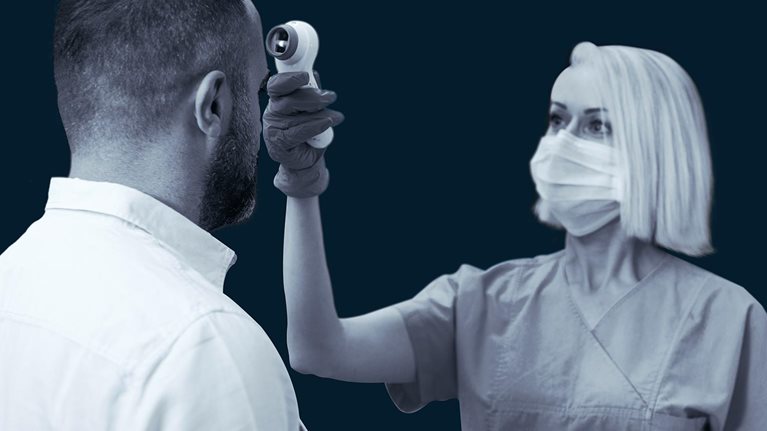The course of the COVID-19 pandemic thus far has not been kind to optimists. Those who pointed to early successes in some areas have been shaken by subsequent waves of infection. Those who hopefully reopened businesses and community organizations have been shaken when new cases popped up. Today, it’s hard to be optimistic in the face of the tragic human outcomes: more than 900,000 people around the world have died, including more than 200,000 Americans. Meanwhile, 13.6 million Americans remain unemployed. And for each month of delay in getting the virus under control, more will die—and the return of GDP to precrisis levels will be delayed by about two months.
Nonetheless, we have made progress. As slow as it may seem, we’ve continued to learn more about the natural history and epidemiology of COVID-19. We’re developing better diagnostics, including rapid point-of-care tests, a few of which can be completed in about 15 minutes. An army of doctors and researchers around the country has been managing and treating the disease and producing a wealth of new knowledge on treatment strategies and procedures. To date, the US Food and Drug Administration has reviewed 310 drug trials, and nearly 600 more are in the planning stages.1 Pharmaceutical companies have also turned out a remarkably robust pipeline of vaccine candidates: 51 are already in human trials as of this writing and more than 250 in all are in development.
On balance, as our colleagues suggest, normalcy might resume in the first half of 2021, and herd immunity could be reached in the second half. And as medical progress builds, there may yet be a place for optimism. If we stay focused and maintain discipline, a best-case scenario to control the pandemic might be reached—perhaps as soon as next summer. It will be difficult. It will take investment and coordination. Setbacks along the way are probably inevitable, and less hopeful scenarios are a distinct possibility. What follows is an overview of the current state of the essential recovery elements that support an optimistic outlook: we’re getting better at reducing transmission, improving case management, and developing a robust pipeline of vaccines. All these also support a hopeful prognosis for the economy.
Getting better at reducing transmission
We continue to collect more natural history and transmission data on the prevention of COVID-19 infections. The understanding of the benefit of masks, physical distancing, and travel restrictions, as well as the risk levels of various activities, continues to improve by the day. So far, more than 1,500 published scientific articles describe COVID-19’s characteristics and modes of transmission, and more than 18,000 have discussed prevention, control, responses, and management strategies. For example, most research confirms that wearing masks, physical distancing, and limited capacity are the keys to reducing the risk of transmission in indoor spaces. Similarly, the risk of transmission is lower in outdoor spaces where people wear masks and keep six feet away from others.2 Under the best-case scenarios, this knowledge will be translated into appropriate public-health measures and interventions that the public actually follows, preventing transmission without structurally impeding economic recovery.
To build public confidence and strengthen the resolve to reduce levels of transmission, we need not only an improved understanding of it but also the transparent communication of accurate actual case counts. Although testing capacity is still well below estimates of what is needed, it has generally improved. In addition, researchers are developing several novel technologies for screening and diagnostic testing at a lower cost and more quickly, with a better experience for the patient. For example, one card-based antigen test can generate results for just $5 in about 15 minutes with a high level of specificity, though with a shorter detection window than the gold standard (the reverse-transcription polymerase-chain-reaction test) can boast.3 Recent data suggest that saliva-based testing is as effective as nasal swabs.4 To improve speed and scalability, companies are also exploring a large number of gene-editing and membrane-protein treatments across CRISPR5 and LAMP6 platforms. Screening tests relying on breathalyzer technologies are being evaluated to screen people quickly before they enter public areas such as schools and airports.
Taking full advantage of the progress of science and technology in reducing transmission requires behavior change, communication, and education at all levels. A wary and skeptical public must be persuaded to follow public-health measures and interventions if they are to be effective. Physicians and health providers must define proper use cases for both screening and diagnostic tests coming to market if they are to be effective. Given COVID-19’s high level of contagiousness, defining and applying test use cases without a proper understanding of test characteristics and human behavior might provide an unwarranted sense of security—for example, by providing false-negative test results—and thereby unintentionally cause an infected person to break with other directives, such as distancing and mask wearing.
Improving case management
At the beginning of the pandemic, the proportion of people dying from COVID-19—the case fatality rate—was over 10 percent in the United States and as high as 20 to 30 percent elsewhere. Patient demographics, overwhelmed health systems, lack of testing capacity, and a limited experience and understanding of managing the disease were largely responsible. Progress since then bodes well for a more hopeful scenario even if vaccines are delayed.
Over the past six months, mortality has declined. The precise numbers depend on underlying assumptions about, for example, complicating conditions and excess deaths, but are generally around 1 or 2 percent. This improvement results in part from the availability of therapeutic treatments, such as remdesivir, which have been authorized for emergency use to treat COVID-19 and appear to have significantly reduced the death rate.7 Improved clinical knowledge of the disease and experience managing it have also played a role. For example, pilots of “virtual wards,” which use telemedicine and remote monitoring to care for patients in their homes, have shown promising early results. These would enable healthcare providers to intervene medically at an early stage while reserving hospital capacity for patients with the most urgent need.8
More help is on the way: a raft of new therapeutics is now in the development pipeline. More than 300 unique therapeutic agents have already progressed to late-stage (Phase III) human trials. One of these agents, the first COVID-specific treatment with neutralizing antibodies isolated from recovered patients, has shown early potential.9 Neutralizing antibodies have been effective in other diseases, such as Ebola, and could act as a stopgap until herd immunity can be established through broad-based vaccines.
The success rates of past therapeutics in various stages of the approval process are reassuring. Even assuming conservative criteria to define (admittedly subjective) medically sound endpoints and trial-design factors, past success rates suggest that more than a dozen therapeutic treatments will be approved for COVID-19 (Exhibit 1). As more of them are brought into use, the mortality rate for COVID-19 could continue to fall—it is not unrealistic to expect it may approach 0.1 percent, given that 0.2 percent has been achieved in countries with broad testing.

To be clear, the therapeutics are still challenging. An uncoordinated rush to develop them led to a large number of clinical trials that lacked the resources to produce definitive conclusions. A number of ongoing trials continue to focus on products that have been shown not to work, competing for precious clinical resources. In addition, researchers have found it challenging to enroll patients in clinical trials, whether because of overwhelmed health systems, an insufficient number of local cases, or the unwillingness of patients to enroll if they may get a placebo. However, medical experts experimenting with and adapting protocols have already made significant progress, ensuring that we have supplies of tools that work and bringing new tools to bear.
Developing a robust pipeline of vaccines
With the continued reduction of transmission levels and decreased mortality from COVID-19, we can begin to get the disease under control. Prophylactic vaccines that prevent infection and transmission would be the final part of the most hopeful scenarios for ending the pandemic. Six months into it, scientists, industry, and governments across the globe are working in unprecedented collaboration to develop such a vaccine.
Researchers have not only tested a large number of candidates but are also deploying a wide range of cutting-edge technologies, including RNA-based research.10 As a result, they’ve made significant progress. Ten vaccine candidates have announced potential timelines for emergency-use authorization or are currently in late-stage testing (Phase III or Phase II/III), with a significant number of human volunteers, so that their safety and efficacy can be measured. Compare that with the historical average over the past 20 years: seven years needed to develop a vaccine. Early results indicate that candidate vaccines elicit levels of antibodies exceeding those from recovered patients.11
While no probability assessment can entirely rule out the worst-case scenarios, in which no successful vaccine emerges, the sheer volume of vaccine candidates gives reason for hope. Applying the historical probability of success for anti-infectious disease vaccines to the number of known vaccine candidates in late-stage trials indicates that about six vaccine approvals are likely (Exhibit 2). The situation is fluid; it is unclear if expedited approval, say, or emergency authorization will change the odds. But with several “shots on goal,” and based on what we know about the vaccine-development process, some vaccine candidates are likely to become available between the fourth quarter of 2020 and the beginning of 2021.

In addition, the at-risk ramping up of manufacturing capacity could make as many as a billion doses of COVID-19 vaccines available globally by the end of 2020 (an estimate based on manufacturers’ announcements). As more vaccines are approved and more doses become available, viral transmission rates may drop significantly—assuming sufficient public submission to vaccination.
A number of obstacles remain. The development of vaccines is inherently risky because of the high safety bar for inoculating the healthy population. Moreover, many leading vaccine candidates use unproven platform technologies. No RNA vaccines have ever been approved. Vaccines utilizing adeno-associated viruses to activate the body’s T-cell defense mechanisms were previously approved only for Ebola vaccines, and they were not widely deployed. In addition, even though vaccines may be available around the fourth quarter of 2020, they may be limited to use for specific groups of patients, and the supply and cold supply chain may be constrained. Finally, the potential for reinfection, while currently thought to be unlikely, is yet unknown—so a seasonal-vaccine approach, similar to that for flu, may be required. In the end, the most momentous challenge ahead may be psychological rather than epidemiological: getting a wary, reluctant, or even disbelieving population to submit to the vaccines or inoculations available.
The tenacity of SARS-CoV-2 (the novel coronavirus) has shaken global confidence even in places where COVID-19 has at times seemed to be under control. Despite those setbacks, we have made much progress over the past six months. Given what we now know about preventing transmission and treating the disease, as well as the robust pipeline of vaccines being developed, there is reason to hope once again that we can put the pandemic behind us. If global financial systems don’t suffer long-term structural damage, the economic recovery could proceed quickly—though a broad and sustained recovery will require ongoing investment in human and physical infrastructure and the continued adaptation of business models, including digital technologies.
Strong leadership can meaningfully tilt the odds toward this hopeful outcome. That will take courage, a bias for action in the face of uncertainty and retrospective criticism, collaboration across institutions, and the moral suasion to build a sense of higher purpose among the people.


